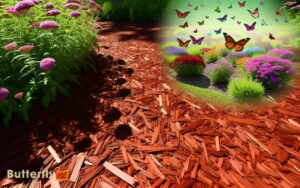What Are Yellow Butterflies Called?
Yellow butterflies, often seen fluttering in meadows and gardens, primarily belong to several notable species including the Common Sulphur (Colias philodice), Cloudless Sulphur (Phoebis sennae), and Orange Sulphur. These butterflies are known for their vibrant yellow wings, which serve both as camouflage and a warning to predators.
They inhabit sunny environments ranging from southern Canada to northern Mexico and exhibit life cycles that include egg, larva, pupa, and adult stages. Some species such as the Clouded Sulphur display distinct sexual dimorphism and have migration patterns that optimize survival.
For those interested, further details reveal their ecological roles and adaptations.
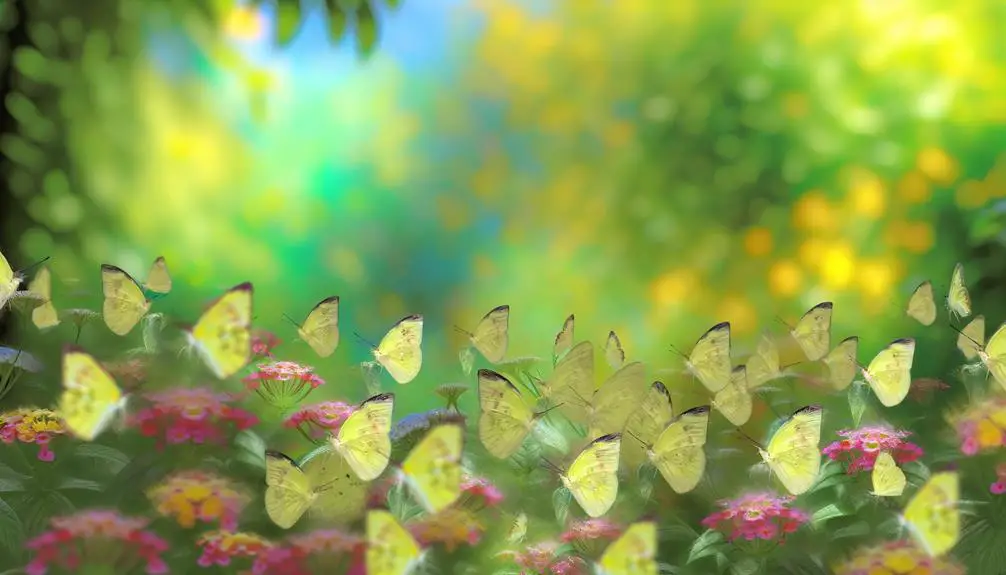
Key Takeaways
- Common Sulphur (Colias philodice): Recognized for pale yellow wings, found across North America.
- Cloudless Sulphur (Phoebis sennae): Noted for bright yellow color, inhabits sunny habitats from southern Canada to northern Mexico.
- Orange Sulphur: Features vibrant orange-yellow wings with black borders, common in meadows and fields.
- Common Brimstone: Known for its leaf-like yellow wings, primarily found in Europe and parts of Asia.
Common Yellow Butterflies
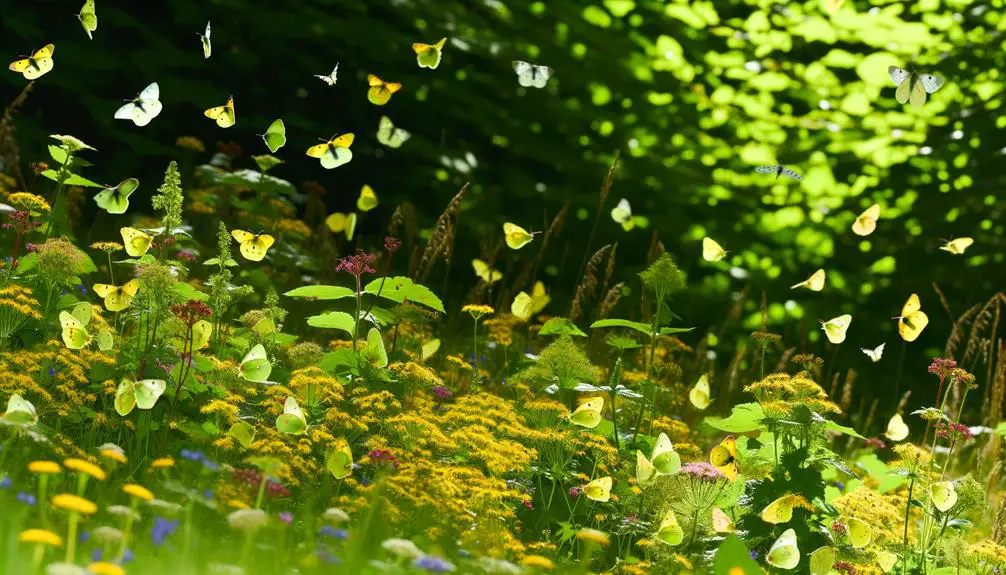
Among the myriad of Lepidoptera, several species of yellow butterflies stand out due to their distinct coloration and widespread prevalence across various habitats. Notable among these are the Common Sulphur (Colias philodice) and the Cloudless Sulphur (Phoebis sennae).
These species exhibit a vibrant yellow hue, which serves both as a mechanism for camouflage among yellow flowers and as a warning signal to potential predators. Typically found in meadows, fields, and gardens, these butterflies contribute to pollination, thereby playing an essential role in maintaining ecological balance.
Their life cycles, marked by stages of egg, larva, pupa, and adult, are influenced by seasonal changes, with many undergoing migrations to optimize survival and reproduction. Their adaptability underscores their ecological significance.
Clouded Sulphur Butterfly
The Clouded Sulphur Butterfly (Colias philodice), distinguished by its pale yellow wings bordered with black, is a prominent species in North America known for its adaptability to diverse environmental conditions.
This species thrives in open spaces such as fields, meadows, and roadsides. The wingspan ranges from 1.5 to 2.5 inches, with sexual dimorphism evident as females often display a more pronounced dark border and occasional white form.
Their larvae feed primarily on leguminous plants, including clovers and alfalfa, making them agriculturally significant.
Adult Clouded Sulphurs exhibit migratory behavior, often moving southward in response to seasonal changes.
Their presence across various habitats makes them an important subject for ecological studies and butterfly population monitoring.
Orange Sulphur Butterfly
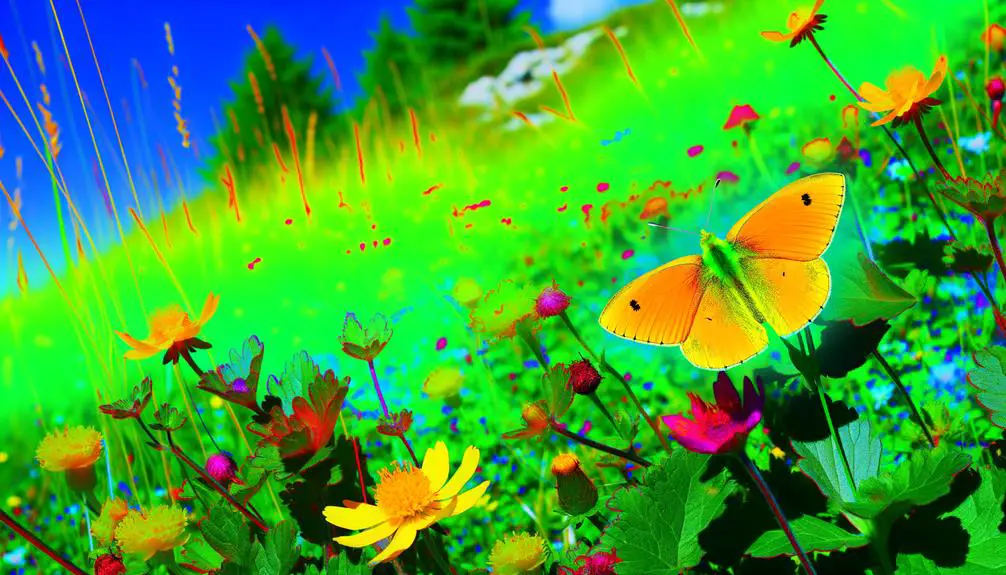
The Orange Sulphur Butterfly (Colias eurytheme) is characterized by its vibrant orange wings bordered with black, aiding in its identification among other sulphur species.
This butterfly thrives in open, sunny habitats such as fields and meadows, spanning a range from southern Canada to northern Mexico.
Its behavior includes a preference for nectar from various flowering plants, and its diet during the larval stage primarily consists of legumes.
Appearance and Identification
Characterized by its vibrant orange-yellow wings edged with a distinct black border, the Orange Sulphur Butterfly (Colias eurytheme) serves as a striking example of Lepidoptera color variation.
The forewings display a small, dark central spot, while the hindwings are adorned with a subtle, light-colored spot encircled by a reddish hue.
Sexual dimorphism is evident, with females often exhibiting more pronounced markings and a paler yellow tone compared to the males.
The undersides of the wings are typically a pale yellow or greenish color, with varying degrees of mottling.
Additionally, seasonal variations can lead to differences in coloration, where summer forms may appear brighter than their overwintering counterparts.
These features facilitate accurate identification within their genus.
Habitat and Range
Occupying a diverse array of environments, the Orange Sulphur Butterfly (Colias eurytheme) thrives in open, sunny habitats such as fields, meadows, and roadsides across North America.
This species is highly adaptable, being found from southern Canada to northern Mexico and from the Atlantic to the Pacific coasts.
Preferring habitats with abundant leguminous plants, which serve as larval host plants, these butterflies are particularly prevalent in agricultural areas where alfalfa and clover are cultivated.
Their presence in disturbed habitats such as parks, gardens, and even urban areas underscores their ecological versatility.
Seasonal migrations influence their range, with populations expanding northward during warmer months and retracting southward as temperatures drop, demonstrating their remarkable adaptability to varying climatic conditions.
Behavior and Diet
Orange Sulphur Butterflies exhibit a range of behaviors that are intricately linked to their dietary preferences, mainly focusing on nectar and specific host plants for their larvae.
Adults primarily feed on the nectar of flowering plants such as clovers, dandelions, and asters. This nectar provides essential sugars and nutrients required for energy and reproduction.
Larvae have a more specialized diet, feeding on host plants like alfalfa, clover, and white sweet clover. These host plants offer the necessary proteins and nutrients for larval growth and development.
Behaviorally, Orange Sulphur Butterflies are known for their territoriality, with males often patrolling and defending their territories to attract females. This territorial behavior helps ensure that males have better access to potential mates while warding off rival males. Their swift and erratic flight patterns play a key role in territorial defense and courtship displays. Some individuals who observe these butterflies up close may experience unease due to a specific phobia, commonly referred to as fear of butterflies name.
Their feeding and mating activities are largely influenced by environmental conditions such as temperature and light.
Common Brimstone Butterfly
The Common Brimstone Butterfly (Gonepteryx rhamni) is particularly noted for its vibrant yellow wings, which serve as an effective form of camouflage amongst the foliage.
This lepidopteran species is widely distributed across Europe and parts of Asia, favoring habitats such as woodlands, meadows, and hedgerows.
The male brimstone displays a more vivid yellow compared to the paler, greenish-yellow hue of the female.
The wings exhibit a characteristic leaf-like shape with pronounced venation, enhancing their mimicry of surrounding leaves.
Larvae mainly feed on buckthorn (Rhamnus) species, while adults primarily subsist on nectar from a variety of flowering plants.
Their lifecycle includes a notable hibernation phase, with adults overwintering in dense vegetation before re-emerging in early spring.
Yellow Swallowtail Species
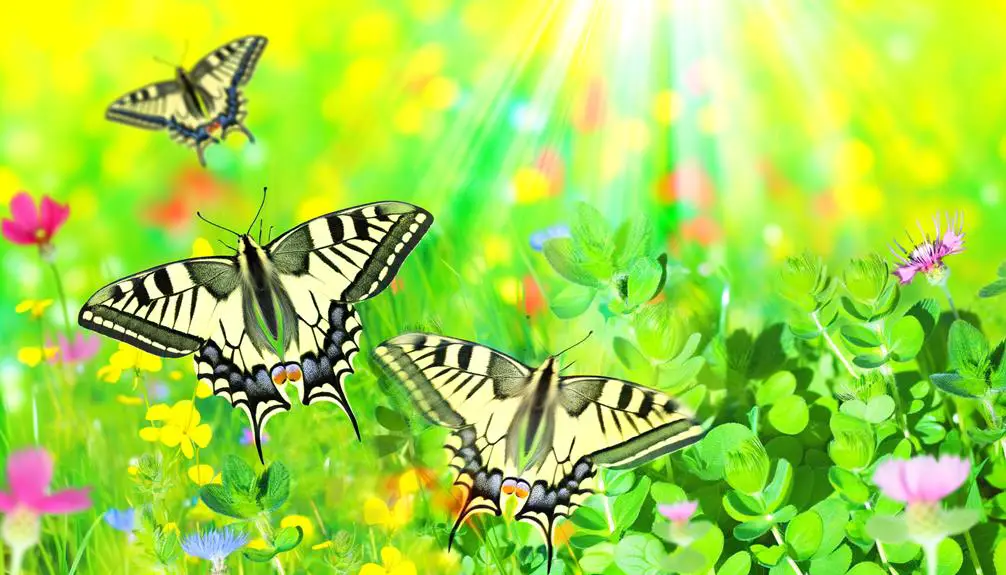
The Yellow Swallowtail species, known for their striking yellow and black coloration, inhabit a variety of ecosystems ranging from forests to grasslands across North America, Europe, and Asia.
These butterflies exhibit distinct physical characteristics, including large wingspans and unique tail-like extensions on their hindwings.
Their life cycle encompasses several stages, from egg and larval stages to pupation and finally, adulthood, each critical for the species' survival and reproduction.
Habitat and Distribution
Inhabiting various regions across North America, the Yellow Swallowtail species primarily flourish in temperate deciduous forests and riparian zones. These environments provide the necessary resources such as host plants for larvae and nectar sources for adult butterflies.
The species shows a preference for regions with abundant water sources, including rivers, streams, and wetlands, which support their lifecycle needs. In addition to natural habitats, Yellow Swallowtails adapt well to anthropogenic landscapes like gardens, parks, and urban green spaces.
Seasonal migrations are observed, with individuals moving northward during warmer months and retreating to southern regions or lower elevations as temperatures drop. This distribution pattern guarantees access to suitable climates and food sources throughout the year.
Physical Characteristics
Adapting to diverse habitats, Yellow Swallowtails exhibit distinct physical characteristics that facilitate their survival and reproduction in varied environments. These butterflies are characterized by their bright yellow wings with black margins and vein-like patterns. The tails on their hindwings, resembling those of a swallow, are a defining feature. Their wingspan ranges between 3.5 to 5.5 inches, providing ample surface area for thermoregulation and efficient flight. The following table outlines key physical attributes of Yellow Swallowtails:
| Attribute | Description |
|---|---|
| Wing Coloration | Bright yellow with black patterns |
| Tail Structure | Swallow-like tails on hindwings |
| Wingspan | 3.5 to 5.5 inches |
| Antennae | Club-shaped with sensory receptors |
These adaptations are essential for their ecological interactions and survival strategies.
Life Cycle Stages
Understanding the life cycle stages of Yellow Swallowtail species reveals essential insights into their developmental biology and ecological roles. These butterflies undergo a complete metamorphosis, evolving through four distinct stages:
- Egg: Females lay spherical, greenish eggs on host plants. This stage lasts about 10 days.
- Larva: Caterpillars emerge and feed voraciously on leaves, undergoing five instars over approximately 3-4 weeks. Their appearance shifts from bird-dropping mimicry to characteristic green with eyespots.
- Pupa: The larva forms a chrysalis, which can be brown or green, providing camouflage. This stage can last from a few weeks to several months, depending on environmental conditions.
Each stage is vital for the survival and propagation of the species, reflecting intricate adaptations to their ecosystems.
Characteristics of Yellow Butterflies
Yellow butterflies, primarily belonging to the Pieridae family, exhibit distinctive chromatic patterns that play essential roles in their survival and reproductive behaviors.
These butterflies typically possess wings adorned with vibrant yellow hues, often interspersed with black or white markings. The pigmentation is due to the presence of pteridine pigments, which also contribute to ultraviolet reflectance, aiding in mate recognition.
Their forewings are usually elongated and rounded, providing aerodynamic efficiency. The ventral side of the wings often features cryptic coloration, facilitating camouflage when at rest.
Antennae are clubbed, enhancing sensory reception, while their proboscis is adapted for nectar feeding.
Sexual dimorphism is evident, with males often displaying more vivid coloration than females, which assists in sexual selection.
Habitat and Distribution
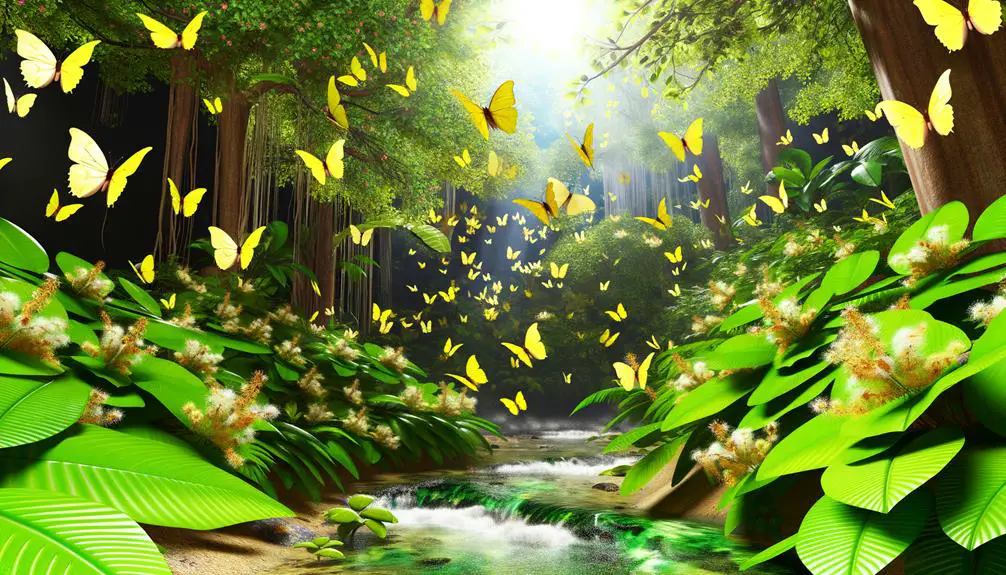
Yellow butterflies of the Pieridae family occupy a diverse range of habitats, including tropical rainforests, temperate woodlands, and open grasslands, reflecting their adaptability and widespread distribution. These butterflies are found on every continent except Antarctica, thriving in various ecological zones.
Their wide distribution can be attributed to several factors:
- Climate adaptability: Yellow butterflies can survive in both humid and arid conditions, allowing them to inhabit various climates.
- Host plant availability: The presence of host plants, essential for their larval stages, influences their habitat choices.
- Migration patterns: Some species exhibit migratory behavior, enabling them to colonize new areas and exploit seasonal resources.
This extensive habitat range underscores their ecological flexibility and resilience in different environmental conditions.
Role in Ecosystems
The widespread distribution and adaptability of yellow butterflies play a significant role in various ecosystems, where they contribute to pollination, serve as prey for numerous predators, and act as indicators of environmental health.
As pollinators, yellow butterflies facilitate the reproduction of many flowering plants, thereby supporting biodiversity and the stability of plant communities.
Their larvae and adult forms provide an essential food source for birds, spiders, and other insects, influencing trophic dynamics.
Additionally, the presence and abundance of yellow butterflies often reflect the quality of their habitat, making them useful bioindicators for ecologists.
Their sensitivity to climate changes and habitat degradation allows researchers to monitor ecosystem health and detect early signs of environmental stress.
Observing Yellow Butterflies

Observing yellow butterflies requires a keen eye and understanding of their behavioral patterns, preferred habitats, and seasonal variations. These butterflies, often members of the Pieridae family, exhibit specific traits that aid in their identification and study.
- Behavioral Patterns: Yellow butterflies are diurnal and are most active during sunny days. They exhibit nectar-feeding behaviors and are frequently seen fluttering around flowering plants.
- Preferred Habitats: These butterflies thrive in open, sunny environments such as meadows, gardens, and forest clearings. They avoid dense, shaded areas.
- Seasonal Variations: The presence and prevalence of yellow butterflies can vary with seasons, often peaking during spring and summer when their larval host plants are abundant.
Understanding these factors is essential for scientifically accurate observation and study.
Conclusion
Yellow butterflies, such as the Clouded Sulphur, Orange Sulphur, Common Brimstone, and Yellow Swallowtail, present a vibrant and ecologically significant presence across various habitats.
These species contribute to pollination and serve as indicators of environmental health.
An interesting statistic reveals that a single Clouded Sulphur butterfly can travel up to 12 miles in search of nectar, illustrating their extensive range and essential role in ecosystems.
Their distribution and behavior underscore the intricate connections within natural environments.




